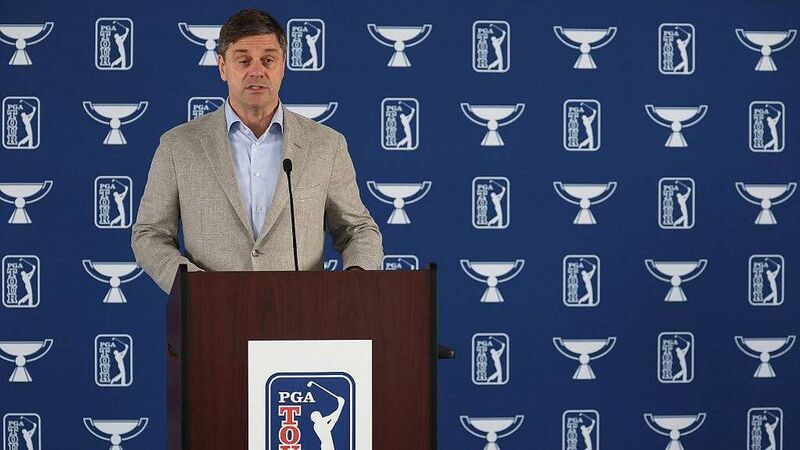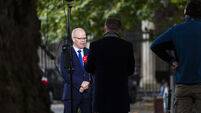PGA Tour has fewer cards and smaller fields. But the big changes are still to come

The three guiding principles for Brian Rolapp since he took over as CEO of PGA Tour Enterprises have been parity, simplicity and scarcity. Pic: Kevin C. Cox/Getty Images)
Sunday at Sea Island was supposed to be looked upon as doomsday for so many PGA Tour players who left the final event of the PGA Tour season without a full card.
This was the year the tour eliminated 25 cards, lowering the bar to No. 100 in the FedEx Cup standings to retain full status for 2026. The developmental Korn Ferry Tour offered only 20 cards to the big leagues, down from 30 cards the previous year. The fields will be smaller next year.
It just didn’t feel like the end, perhaps because the next chapter remains so uncertain.
Lee Hodges had a 10-foot birdie putt he missed on the final hole that would have moved him into the top 100. Ricky Castillo thought he got it done with a closing 62, only for Max McGreevy to make a 30-footer birdie putt on the last hole that knocked him out.
Both are likely to be in Honolulu for the Sony Open on Jan. 15 for the start of a new season.
Has anything really changed? Not yet.
There might not be as much opportunity, but there are tee times. And that’s all anyone can ask in a game where success is still tied to a score.
PGA Tour officials have been crunching numbers and their best estimate is the leading 10 players who missed out on the top 100 will have access next year to about 16 of the tournaments. That doesn’t include the eight $20 million signature events, the four majors, the three FedEx Cup playoff events and The Players Championship.
A few of them can still play their way into the big stuff. Otherwise, they might feel like they’re playing on a different tour.
Perhaps that was the idea all along.
“I know it’s going to get tougher and tougher, and the goal posts are moving a little bit,” Harris English said last week. “I know it’s going to get harder for me. I’m 36 years old. I’m not getting any younger. But we’ll see where it goes. Everybody is in for the good of the PGA Tour and to make our product the best it can be.
What that product looks like remains to be seen.
English shared what amounted to water cooler conversation when he said “the talk of the tour” was perhaps waiting until the Super Bowl was over to start the season. That sounds like one of the options the Future Competition Committee chaired by Tiger Woods is contemplating.
English usually doesn’t make headlines unless his caddie can’t get into the U.K. or his name is slipped into the Ryder Cup envelope that keeps him from playing singles.
“Just speculation,” he said with a shrug before teeing off Sunday.
Such a move is plausible considering how often Brian Rolapp, the new CEO of PGA Tour Enterprises, talks about “scarcity” in a bid to make the golf season worth watching from start to finish.
Two days after English was talking golf and football, Rolapp was in Palm Beach Gardens, Florida, for the CNBC CEO Council Experience Forum. He was asked whether he could see a schedule that didn’t start until the Super Bowl ended.
“Yeah, I could see that,” Rolapp said Friday.
And to think that former PGA Tour Commissioner Tim Finchem once set a 20-year goal in 2000 for golf to surpass the NFL in fan base. The tour has been running from the football ever since.
“If you dig deeper into what he (English) said, it’s not that complicated,” Rolapp said. “Competing with football in this country for media dollars and attention is a really hard thing to do.”
The Future Competition Committee was formed in August and didn’t meet for the first time until a month ago. More telling was when Rolapp said he has invited media partners — and some media groups not (yet) involved in golf — to seek their ideas.
One advantage for Saudi-backed LIV Golf — besides the funding — was being able to start a league from scratch without more than 60 years of having operated roughly the same way. Blowing up a proven product can be messy.
“Part of professional golf’s issue is it has grown up as a series of events that happened to be on television,” Rolapp said. “As opposed to, ‘How do you actually take those events and make them meaningful in their own right, and cobble them together in a competitive model — including a postseason — that you would all understand whether you’re a golf fan or a sports fan.’”
He said it was key for the committee to start the process with more questions than answers. His message to the media partners was simple.
“Blank sheet of paper,” Rolapp said. “What would you do? How would you make this great to increase fan engagement?”
His three guiding principles since he took over have been parity, simplicity and scarcity.
“The bad news is golf only has one,” Rolapp said, referring to parity. “But it’s the hardest one to get.”
Eight players won the eight signature events this year. Scottie Scheffler won a signature event, two majors and a FedEx Cup playoff event. Also, three tournaments Scheffler played were won by players outside the top 50 in the world ranking at the time.
"What worked in the NFL — and I think all sports are chasing — is how you make the tightest competition possible so on any given Sunday you don’t know who’s going to win,” Rolapp said. “Golf has that. That is incredible strength.” It’s the other two that are the subject of debate.
“How do you actually make a competitive model that’s simple to understand? And how do you make scarce events that fans want to follow? Those are the principles guiding the competitive model,” he said. “I think we’ll know in a handful of months where we come out.”
Maybe then it will be time for players on the outside to get nervous.














